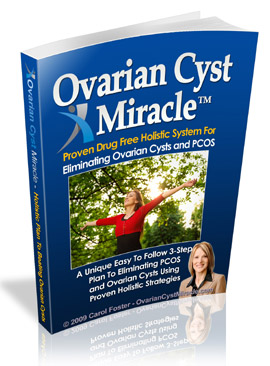Ovarian Cyst Miracle
Ovarian Cyst Miracle
Ovarian Cysts – Risks and Complications
(This article is based on the book, Ovarian Cyst Miracle by Carol Foster. Carol is an author, researcher, nutritionist and health consultant who dedicated her life to creating the ultimate holistic ovarian cyst solution guaranteed to permanently cure all types of ovarian cysts and dramatically improve the overall quality of your life, naturally, without the use prescription medication or surgery, and without any side effects. Learn more by visiting her website here)
Click Here To Learn About Ovarian Cyst Miracle
Understanding Ovarian Cysts
Ovarian cysts are fluid filled sacks, which are formed within the ovary. Cysts, which are bigger than two centimeters, are formally diagnosed as ovarian cysts. Many ovarian cysts are functional in nature. That is, they are beginning and rarely ever cause complications. However in some cases, the cysts may develop certain complications.
Risks and complications of ovarian cysts depend on the type of cyst and the stage of treatment. Some types of risks complications, which are associated with ovarian cysts, include the following – Ruptured ovarian cyst, Ovarian torsion, Peritonitis, Infertility, Cancer.
This is one the most serious form of complication. Ruptured ovarian cyst can lead to internal bleeding and in some cases it can be very dangerous. Ruptured ovarian cyst can cause hemorrhage, which requires immediate medical attention.
Sometimes, there is also twisting of the ovary, which can lead to infertility. Ovarian torsion may disturb blood supply to the ovary as well. This leads to another complication called as ovarian necrosis, which leads inflammation and septic shock
Pertitonitis is the inflammation of the mucus membrane. As this membrane lines the abdomen cavity, it can cause excruciating pain and in some cases the resulting complications can be life threatening.
Infertility caused by ovarian cysts can be temporary or permanent depending upon the extent of the damage. Hence, women suffering from ovarian cysts and those desirous of starting a family should take ovarian cysts really seriously.
In rare but significant instances, ovarian cysts may even turn cancerous. The patient will then require the usual cancer treatment along with surgery, where generally both the ovaries are removed.
Click Here For Ovarian Cyst Miracle Book
Besides these serious complications and risks, ovarian cysts also lead to excruciating pain and hormonal imbalance. This can affect the mental and emotional well being of the patient as well. However, conventional medicine very rarely pays attention to the mental and emotional complications that may develop because of ovarian cysts. The treatment options can cause many side effects like loss of fertility, weight gain, and reoccurrence of stronger cysts. Therefore, many women find it difficult to cope with the demands of the conventional treatment, which can worsen an already difficult condition.
Hence, to overcome the risks and complications of ovarian cysts along with the disease, you will need a, more comprehensive and holistic approach. Holistic approach is very effective as it treats the root cause of the condition and not the symptoms. Symptoms are attractive propositions to treat as relief in symptoms give a false sense of security. However, holistic approach shatters this conventional thinking by clearly eliminating the root cause. Therefore, holistic approach can not only treat ovarian cysts, but can also prevent the risks and complications of ovarian cysts in the bargain.
Learn more by visiting her website here


